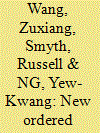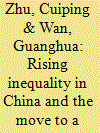| Srl | Item |
| 1 |
ID:
159024


|
|
|
|
|
| Summary/Abstract |
Most analyses explain the increase in China's overall inequality during the reform period principally by means of the expansion of urban-rural income gap. This paper tries to state a relationship between functional distribution of income and China's Gini index. After presenting the main theoretical contributions that clarify the general relationship among those variables, we describe the mechanism that has connected them during the last decades in the Chinese economy. There exists a link between falling wage share, rising urban households' top incomes, urban-rural income gap and the Gini coefficient. These relationships are analysed for both the pre and post-crisis periods. After estimating the main relationships, the paper ends with a discussion on the ability of potential redistributive policies to reverse this pattern of inequality.
|
|
|
|
|
|
|
|
|
|
|
|
|
|
|
|
| 2 |
ID:
089556


|
|
|
|
|
| Publication |
2009.
|
| Summary/Abstract |
The most common data source on income distribution in China is grouped data. When income data is in grouped form, some acceptable Lorenz model is needed to approximate the underlying Lorenz curve. This paper presents a new family of Lorenz curves and applies the main model in our proposed family of Lorenz curves to income data for rural China over the period 1980 to 2006. We find that the income share of the rural population at the low end of the income scale has been shrinking, income inequality in rural China has increased over time and that income inequality has impeded attempts to reduce poverty. However, the welfare of the rural population is still improving in terms of the generalized Lorenz dominance criterion.
|
|
|
|
|
|
|
|
|
|
|
|
|
|
|
|
| 3 |
ID:
133882


|
|
|
|
|
| Publication |
2014.
|
| Summary/Abstract |
This article provides a statistical decision-making framework for the Gini index through the introduction of practically usable confidence intervals for this index. The resultant intervals enable hypothesis testing with the Gini index as well as providing a mechanism for studying the reliability of its estimates. The article presents these confidence intervals and demonstrates their prospective uses with an illustrative example to officially published estimates for the index from 24 countries
|
|
|
|
|
|
|
|
|
|
|
|
|
|
|
|
| 4 |
ID:
111485


|
|
|
|
|
| Publication |
2012.
|
| Summary/Abstract |
China faces serious external (i.e. trade) and internal (i.e. structural) imbalances. Both are related to income inequality, reduction of which will help to increase domestic demand. This paper discusses how income inequality has evolved over time. This is followed by an exploration of the consequences of high inequality. Driving forces underlying the rising inequality are analyzed before providing concrete policy recommendations. It is found that inequality declined in the early period of reform, until the mid to late 1980s, and then began a rising trend up to 2010. Major determinants of inequality include: location, institutional and policy factors, trade and globalization, and education inequality and human capital gaps along rural-urban and spatial divisions. To achieve a balanced economy and a harmonious society, development policies in China must shift from emphasizing growth to prioritizing equality. In addition, government interventions can target rural-urban disparity through rapid urbanization, and tackle regional inequality by developing financial markets, ensuring progressive allocation of fiscal resources, promoting trade and foreign direct investment in inland China, creating more formal jobs and supporting the service sector.
|
|
|
|
|
|
|
|
|
|
|
|
|
|
|
|